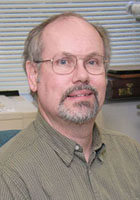 Randy A. Kimble
Randy A. KimbleAstrophysicist, NASA's Goddard Space Flight Center, Code 667, ExoPlanets and Stellar Astrophysics Laboratory, and James Webb Space Telescope Integration & Test Project Scientist.
Systems Engineering Seminar
Performance and Early Results of Wide Field Camera 3:
A Powerful New Imager for the Hubble Space Telescope
Presented by:
Randy A. Kimble /GSFC-667
Astrophysicist, NASA's Goddard Space Flight Center
ExoPlanets and Stellar Astrophysics Laboratory
December 8, 2009, 1:00 p.m.
Building 3 Auditorium
Abstract:
Performance and Early Results of Wide Field Camera 3:
A Powerful New Imager for the Hubble Space Telescope
Wide Field Camera 3 (WFC3) was installed into the Hubble Space Telescope during the highly successful Servicing Mission 4 in May, 2009. WFC3 offers sensitive, high resolution imaging over a broad wavelength range from the near UV through the visible to the near IR (200nm - 1700nm). Its capabilities in the near UV and near IR ends of that range represent particularly large advances vs. those of previous HST instruments. In this talk, I will review the purpose and design of the instrument, describe its performance in flight, and highlight some of the initial scientific results from the instrument, including its use in deep infrared surveys in search of galaxies at very high redshift, in refining the precision of the determination of the Hubble constant, and in investigations of the global processes of star formation in nearby galaxies.
Biography:
After receiving my Ph.D. from the University of California, Berkeley, I spent some years on the research staff of the Department of Physics and Astronomy at The Johns Hopkins University, where I was Deputy Project Scientist for the Hopkins Ultraviolet Telescope during its development and flight on the Astro-1 space shuttle mission.
I joined NASA Goddard in 1990 and served as Instrument Scientist and Co-Investigator for the Space Telescope Imaging Spectrograph (STIS) through its development and successful installation on HST in 1997 and its continuing scientific operations. I have also been a Co-Investigator on the HST/Advanced Camera for Surveys.
From 2002 to 2009 I served as Project Scientist for the Hubble Space Telescope Development Project; among my duties in that position was serving as Instrument Scientist for the Wide Field Camera 3, a powerful new imager that was installed during HST Servicing Mission 4 and which has completed a highly successful orbital verification program. In October 2009, I joined the James Webb Space Telescope program as Integration and Test Project Scientist.
Awards: NASA Exceptional Achievement Medal, 1998; Inducted into Space Technology Hall of Fame, 1997.
Educational Background
B.S. Physics, Massachusetts Institute of Technology, 1974
M.A. Physics, University of California, Berkeley, 1976
Ph.D. Physics, University of California, Berkeley, 1983 (thesis: "Satellite Observations of the Extreme Ultraviolet and Far Ultraviolet Radiation Fields")
Research Interests
My research interests are in astronomical instrumentation, particularly detectors, as well as in star formation and stellar populations, UV background radiation, and the interstellar medium.
Return to NASA GSFC Systems Engineering Seminars Home